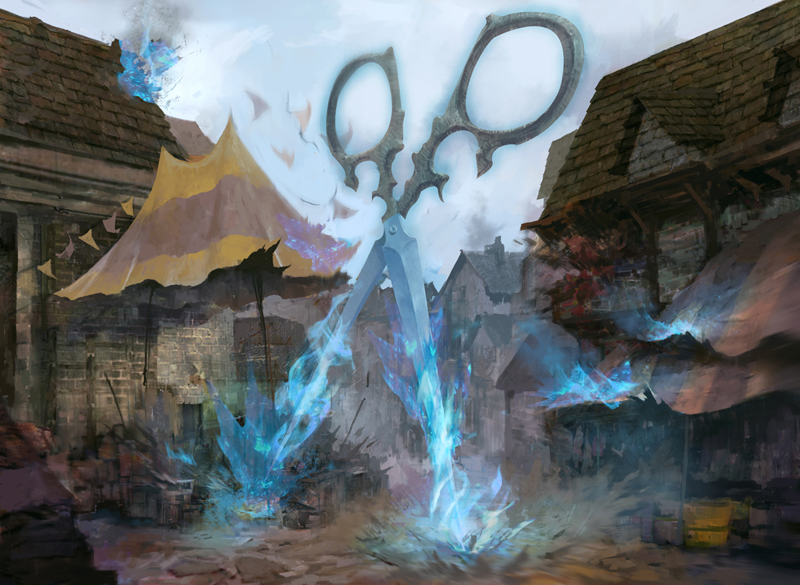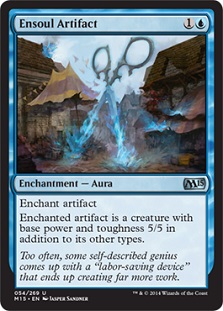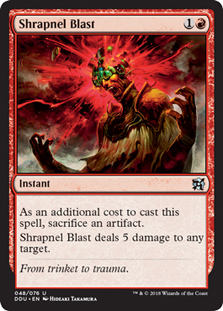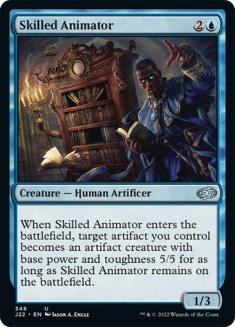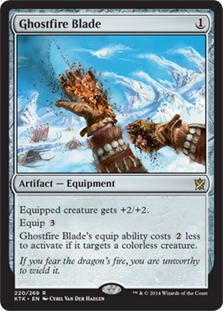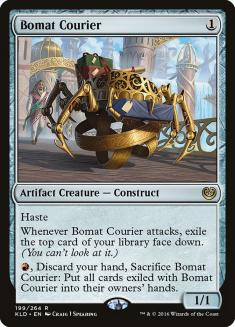In the run up to Players Tour Brussels, the deck I put by far the most time into practicing and learning was Izzet Ensoul. This is partially because the deck does some powerful things, enough so that it is often terrifying to play against (if you want to read more about the deck itself then make sure to check out Ben Friedman article from earlier this week). The other reason though is that it is a really fascinating and fun deck to play, that repeatedly asks you how much risk you’re willing to take, how much you have to try and push through damage right now, all whilst posing complicated combat math against other creature decks too.
Izzet Ensoul is part Affinity, with its cheap, frail artifact creatures working alongside artifact payoff cards to try and sneak through enough damage to take down its opponent. Really, it’s part Infect too though, as so much of the deck comes down to figuring out what removal you can afford to play around, how to weasel interaction out of your opponent’s hand, and when you’re at the point where it’s either worth or even necessary to throw that caution to the wind.
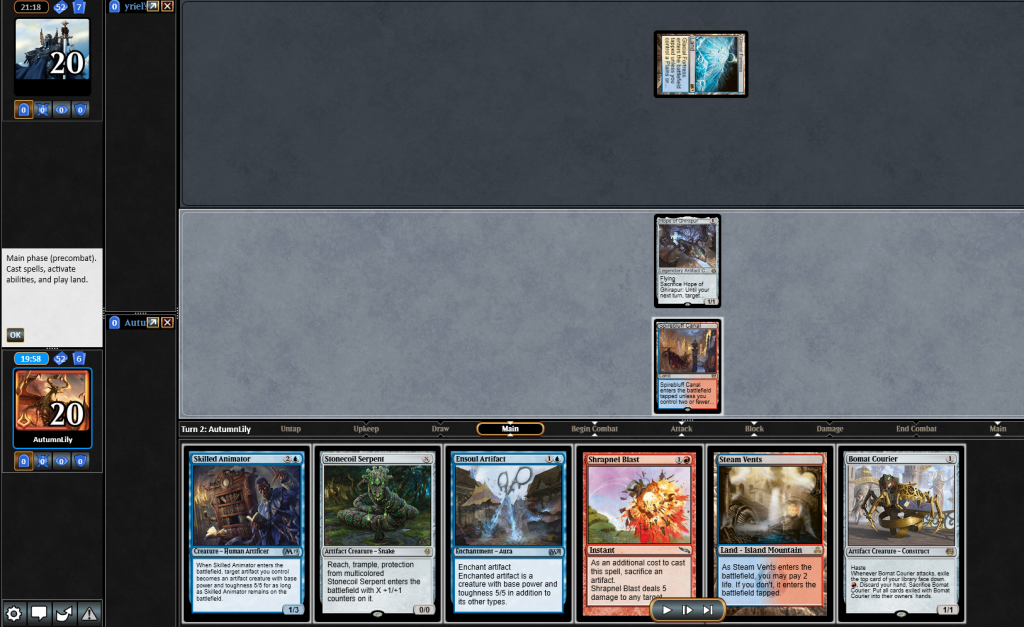
I wanted to start with an straightforward example to illustrate some concepts, so I won’t ask what you should do; against this Azorius Spirits opponent I would always play the Ensoul Artifact here. Knowing that your opponent doesn’t have any interaction means you get to deal a guaranteed five damage this turn; it’s as if you go to resolve the equivalent of a Shrapnel Blast, which makes the actual Shrapnel Blast you have in hand all the better for finishing the game in a few turns time.
Not only do you get that oh so important guaranteed five damage, if your opponent doesn’t have a Brazen Borrower with which to bounce your creature then they’re likely on the hook for at least five more damage (and likely losing this game as a result). Even if they do have the answer it still leaves you in a position where you get to deploy fresh threats onto the now empty battlefield before your opponent can, and your hand has a lot of power in it with which to still close out this game. Sometimes playing the Ensoul Artifact out is an incredibly easy decision.
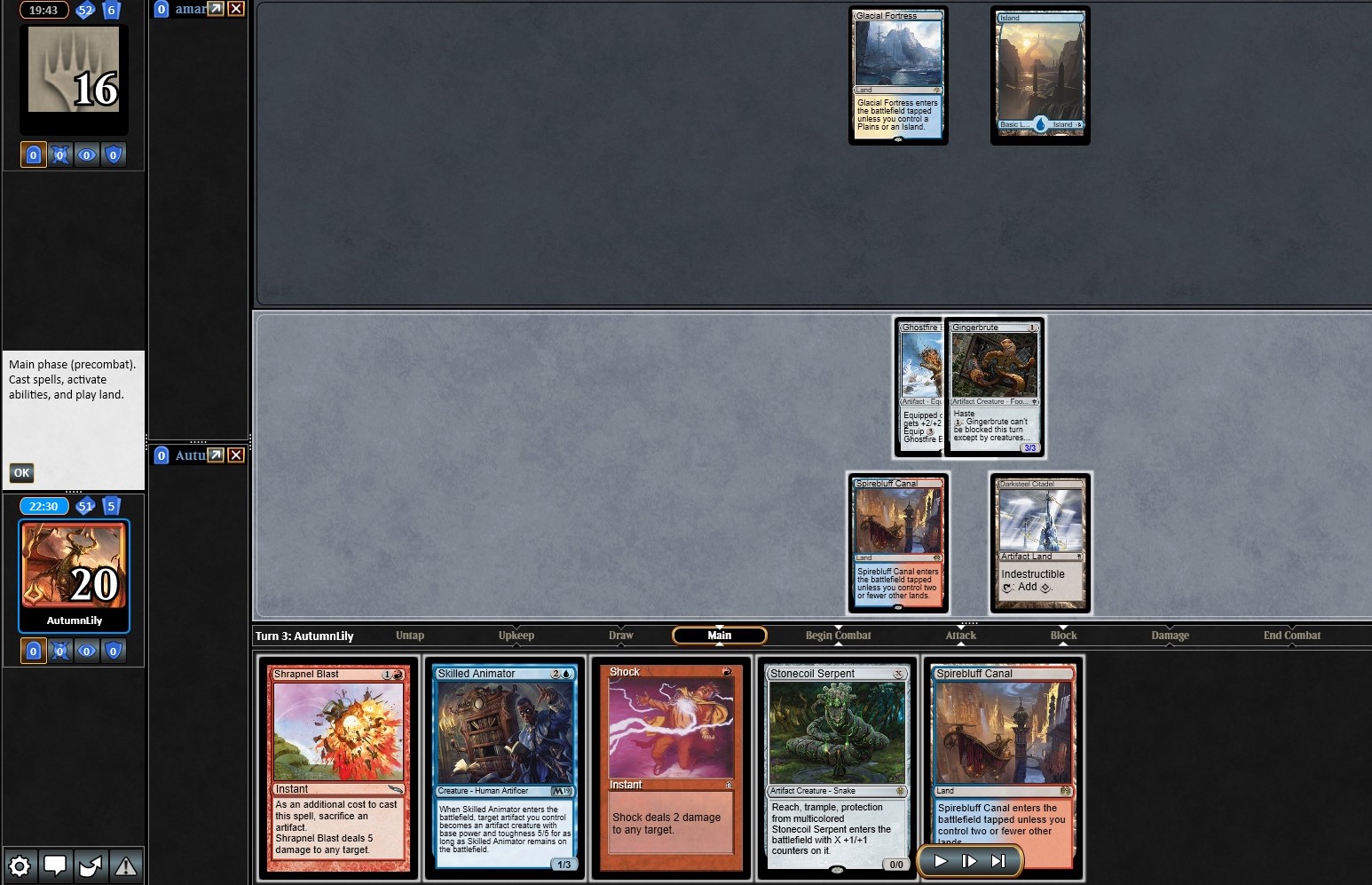
Other times, it is a much less easy decision. This is Game 3 against a different Azorius Spirits opponent. Are we turning something into a 5/5 this turn in the face of this open mana, and if not then what do we do?
Casting Skilled Animator and turning Gingerbrute into a 5/5 means that the opponent would take seven damage this turn, which is a colossal swing. The problem is that if they have Brazen Borrower they then get to cast Petty Theft on our Gingerbrute meaning our Skilled Animator has been largely wasted and we deal no damage this turn. A sideboard card like Isolate is similarly punishing.
Since we’re under no pressure, and even a chip shot of three damage is incredibly meaningful with seven points of burn stored up in hand, I am very happy to just attack for three here and see what happens. Regardless of what our opponent does (they ended up casting Isolate on our Gingerbrute in combat, as it turns out) I then want to cast Skilled Animator targeting our Darksteel Citadel; I don’t care about the indestructibility too much here, but having the Animator target a card that can’t be targeted with Petty Theft means that if the opponent has a copy of that card they’d have to bounce our Animator instead of the creature it is animating, which allows us to replay it and re-make a 5/5 again later in the game.
When you’re under little pressure to end the game or race, and your opponent is representing interaction, it is fine to take a more careful, slower line.
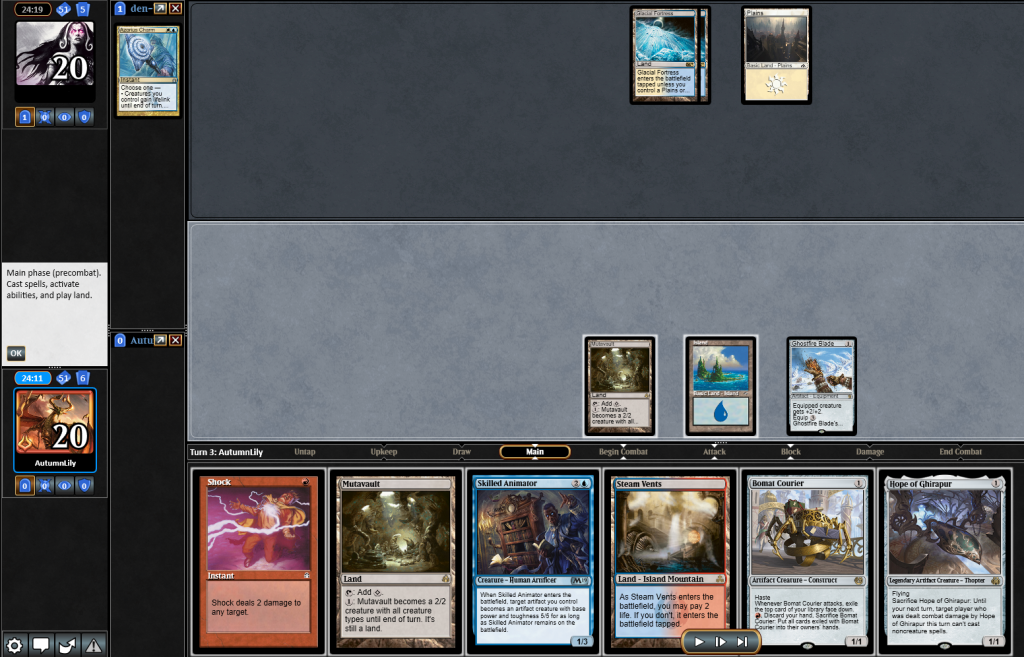
Continuing our journey through a field of Glacial Fortress decks, here we’re on our third turn on the draw against Azorius Control. With multiple spells in hand we have a lot of different options to present into our opponent’s open mana, but how do we proceed?
Azorius Control is a great example of a matchup where we aren’t in as much of a rush to kill them since they take such a long time to take over the game. Our priority here is to make their cards look as bad as possible whilst still managing to develop our game-plan meaningfully at the same time. With this in mind casting Skilled Animator and turning the Ghostfire Blade into a 5/5 is the worst possible option; Censor, Azorius Charm and Absorb all look incredible against this line, and even if you somehow dodge those cards that just means the best case scenario is that you then run both of those cards of yours into a Supreme Verdict which is much worse than it sounds since Ghostfire Blade is one of your best cards in the matchup.
The best way to make your opponent’s cards look bad is to cast the Bomat Courier, equip it, and swing. Censor does nothing against this play, and if they have Absorb we have a follow up play making that card look unexciting too. If they have an Azorius Charm or another way to remove our creature then we can replace the Bomat Courier post-combat with a Hope of Ghirapur, again making their removal spell look bad as we still managed to develop our battlefield more than they answered it.
If they don’t kill the Courier in combat then we’re happy we pushed three damage and developed our battlefield, play a land and say go; with two Mutavaults in addition to a Courier we have enough pressure that we don’t need to make Supreme Verdict look good by playing Hope of Ghirapur as well. You can’t always afford to play this role quite so extremely, and will often take more risks than this, but having a Ghostfire Blade and two Mutavaults offers you a lot of wiggle room.
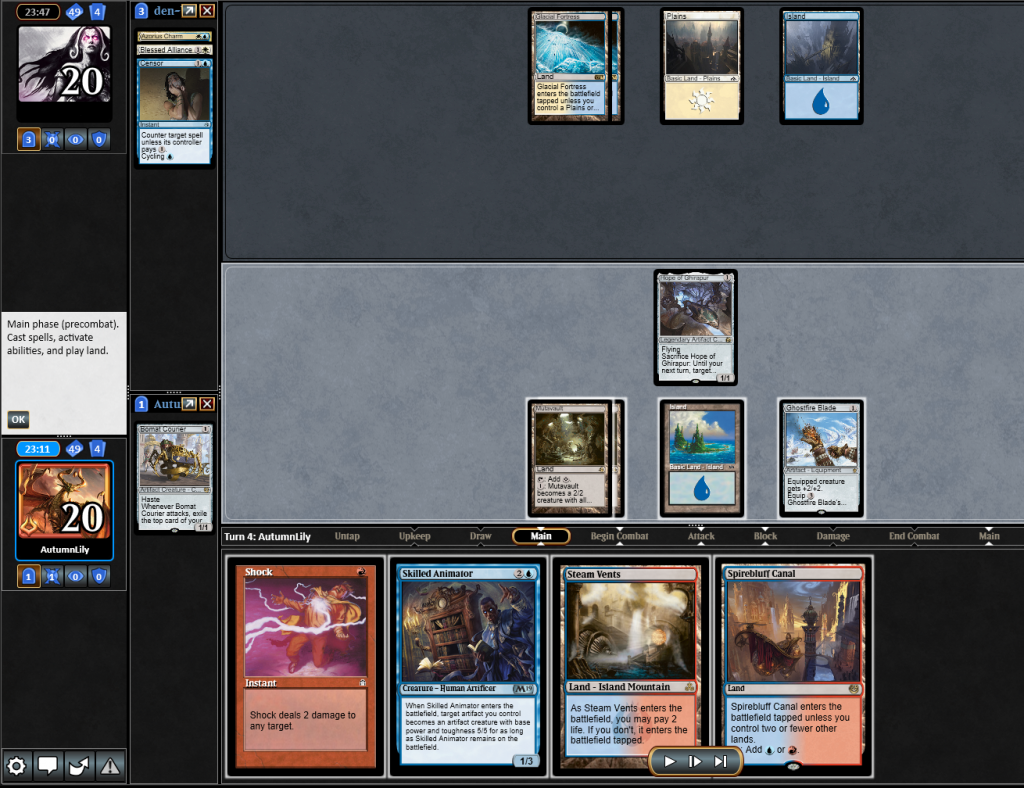
So the previous opponent Blessed Allianced our Courier, we played a Hope of Ghirapur, and then they cycled their Censor, played a land for their turn and passed back to us. What now?
Again, I’m a big fan of whittling away at our opponent rather than going for any big plays into their open mana. Equipping the Hope of Ghirapur with the Ghostfire Blade, firing up a Mutavault, and attacking for five damage is some very meaningful pressure. Settle the Wreckage is brutal for us in that scenario, but it is unreasonable to play around everything; you’re trying to make the range of cards your opponent could very likely have and that we can reasonably beat look bad, not try to make every single card in Pioneer look bad.
As it happened, I ended up narrowly winning this game after my opponent resolved an Elspeth, Sun’s Champion a few turns later, showing that every little bit of pressure we applied was necessary to ultimately beat such a powerful play, but we got there whilst making our opponent’s cards look as awkward as we could.
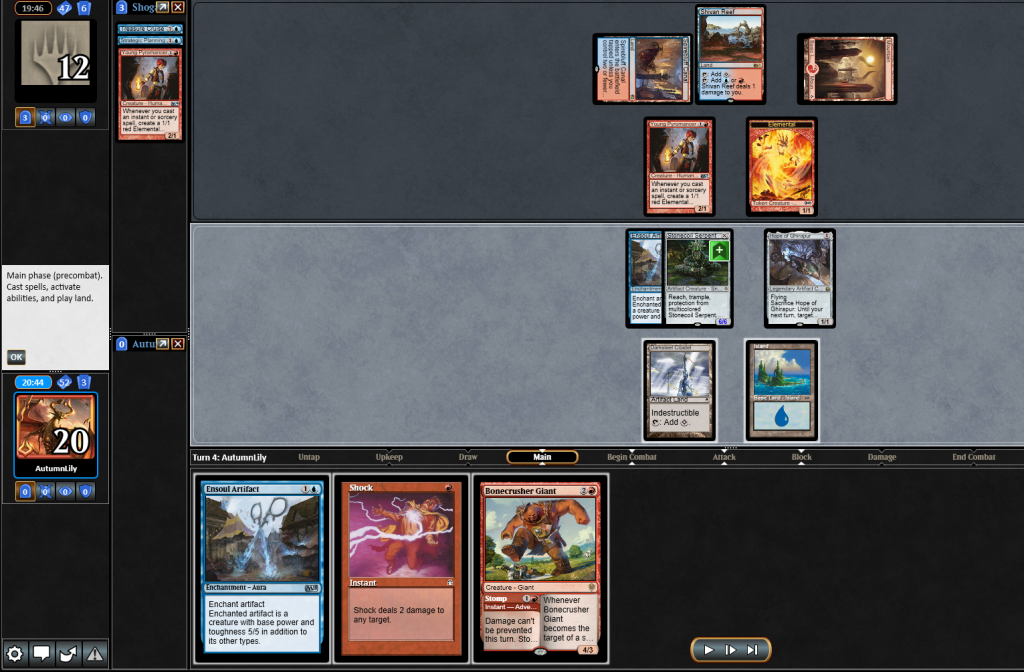
This is the final example of choosing the spot at which to jam your Ensoul effect, this time against a deck not running Glacial Fortress. Here we’re against Izzet Phoenix in a sideboarded game. We find ourselves on the play, even though it may not look like it after mulliganing to a five card, one land hand and missing our second land drop for multiple turns. After our opponent tapped out for a Young Pyromancer we got to hit them with our freshly Ensouled Stonecoil Serpent. They cast a Strategic Planning, leave a single mana open and pass the turn back to us. We know they have Lightning Axe and Wild Slash in their deck, so what do we do for our turn?
The thought process behind not casting Ensoul Artifact on our Hope of Ghirapur would go something like; I don’t want to expose myself to removal from a deck with so much of it and get two-for-one’d in the process. So then, how exactly are we actually winning a game where our opponent has a removal spell in their hand? If we don’t cast this Ensoul Artifact then our opponent gets to Wild Slash our Stonecoil Serpent, shove their battlefield in front of it, and then gets to untap and cast more cantrips to rapidly find another one of their many removal spells. if they have a Lightning Axe then the Axe and a token trade for our Serpent, they take a chunk of damage, but again get to untap and dig for more removal to likely take over the game.
Beating a removal spell here is so incredibly hard and unlikely. This is the very opposite of the situations we had against Azorius Control, things only get worse for us if we don’t take a risk and cast Ensoul here; if they have the answer then we almost certainly lose regardless of what we do, but if they don’t, then casting the second Ensoul makes victory almost guaranteed. When times are rough exercise less caution and put your opponent to the test.
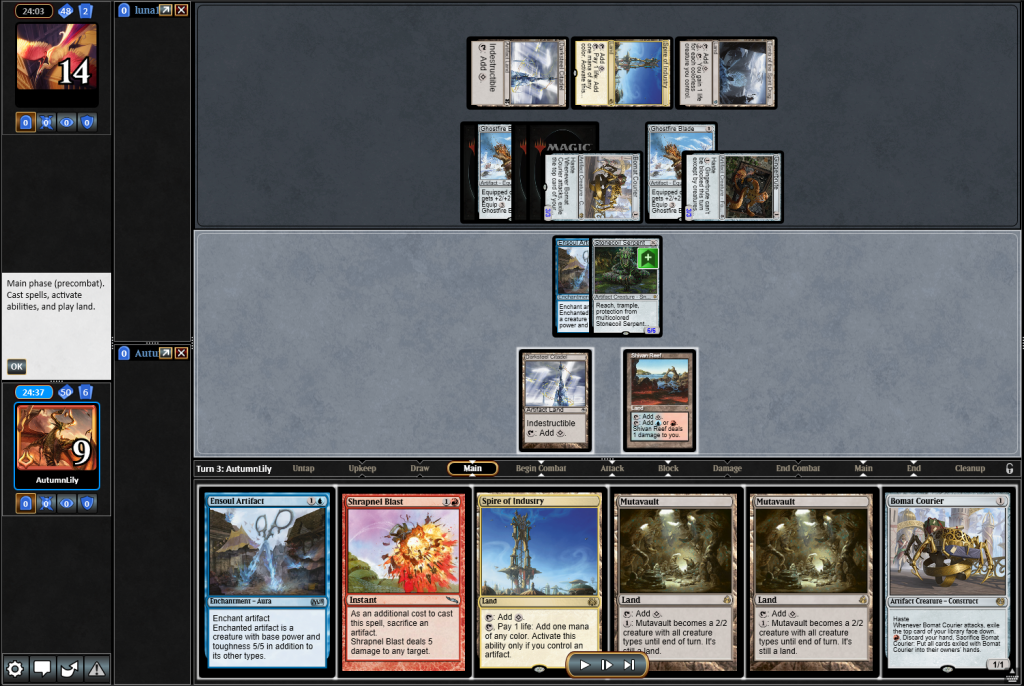
Now for some more fun situations. Combat math and racing are key skills for playing this deck. Here we find ourselves under a ton of pressure in the mirror, but with some explosive damage potential stored up in hand. How do you navigate this situation?
We can attack for eleven damage this turn, but we die to a lot of different cards on the way back and we simply don’t need to attack for that much to have our opponent dead on our next turn. So we need to attack for enough here that we still easily kill our opponent on our next turn whilst making sure we don’t die on their next turn.
A good line to aim for here is that I’d like to be able to beat a Shrapnel Blast from our opponent. This means we need the Bomat Courier on defense as a hasty blocker to tackle down the Gingerbrute if the opponent tries to make it large enough to pair with a Shrapnel Blast for lethal. With the Gingerbrute on defense we can play a Mutavault out too, and swing in for six damage with our Serpent putting our opponent to eight life. We’re delivering just enough pressure, and having Gingerbrute alongside either a Mutavault activation or Shrapnel Blast as needed should allow us to get through to our next turn safely against a pretty reasonable range of hands from our opponent, even if they do have a Blast of their own.
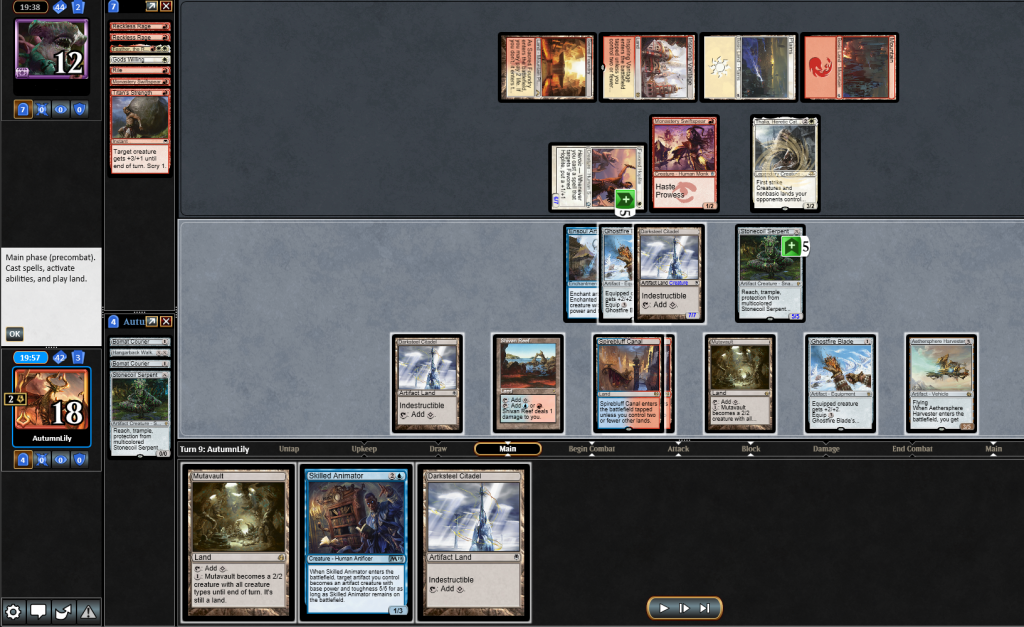
Game 3 against Boros Feather, we come across this deeply complicated battlefield. Take a deep breath, parse all this information, then tell me what your gameplan is here.
It’s very easy to get caught up in all the details here and miss that you actually have lethal. I didn’t see this initially, and have had a few other people miss it, and thought it a nice include in among examples of racing scenarios where you’re not necessarily looking for lethal. Skilled Animator can’t crew the Aethersphere Harvester due to Thalia, Heretic Cathar, but making this vehicle into a 5/5 makes it fly regardless, and then moving your Ghostfire Blades to either the trampler or the flyer will kill your opponent despite their two blockers. It’s very easy to get caught up in all the details on the battlefield, the way Thalia is making a lot of other lines not quite work, and miss an interaction like how Animator and Harvester work together as a result of all these distractions.
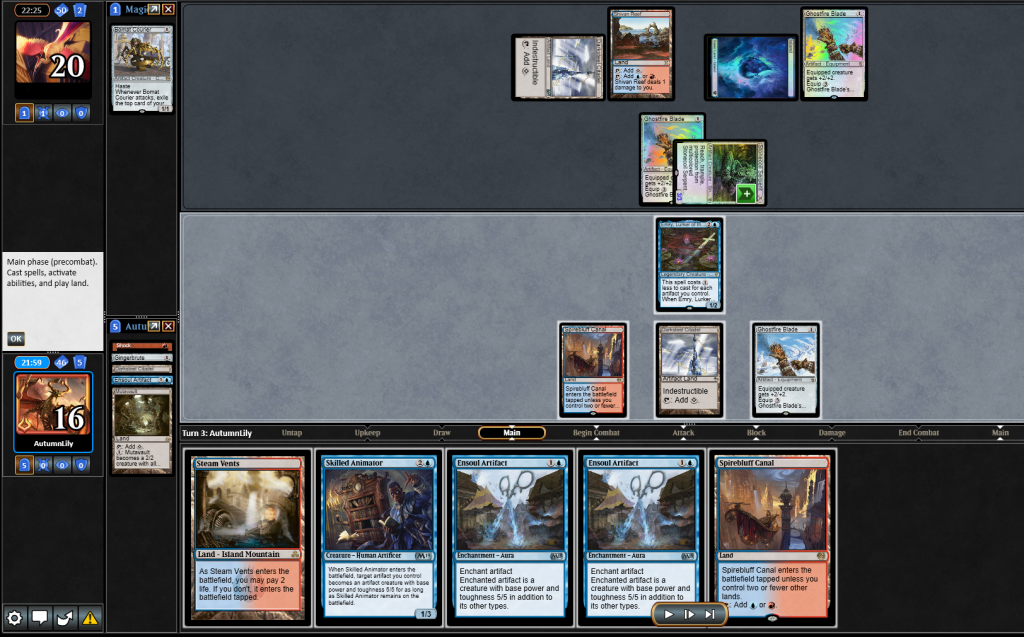
With your opponent on 20 life here, this time you definitely don’t have lethal. You do have an active Emry, Lurker of the Loch though, and our cards in hand represent a lot of damage output. For our final scenario today, what’s the best approach here?
Here’s the thing; I’m actually really scared of dying here. Our hand is quite strong, and can probably overpower a lot of things our opponent could represent here, but if we swing this turn we’re only representing a three turn clock, and our opponent’s Stonecoil Serpent, suited up with two Ghostfire Blades, only barely doesn’t represent a three turn clock on the way back on its own. This isn’t a race that I quite feel ready to engage in.
With this in mind I’m interested in presenting a blocker, and the best way to do that is by enchanting our Darksteel Citadel with an Ensoul Artifact and holding it on defense. Our Emry can then happily swing in for a damage, and hopefully trying to slow down the game will help us take advantage of all the power in our hand.
With our final scenario done, hopefully walking through all this has helped give you a good idea of skills you need to train in order to wield this powerful deck. This article is a bit different from my usual, so let me know if you enjoyed it and would like to see more content like this in the future!

